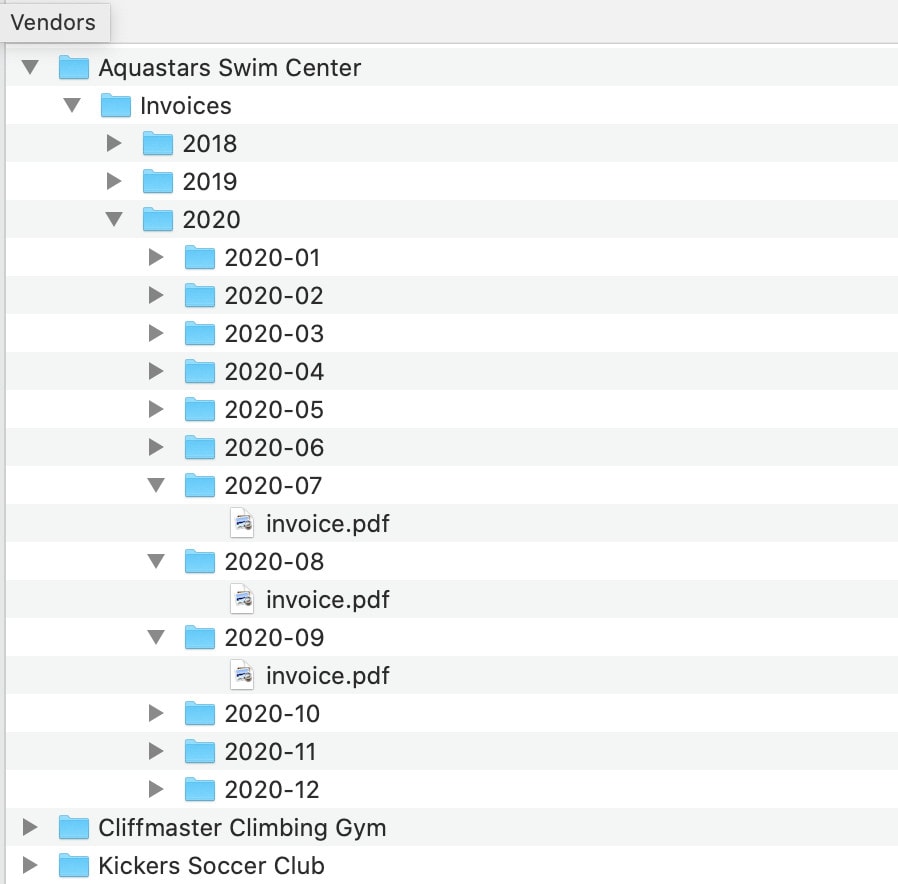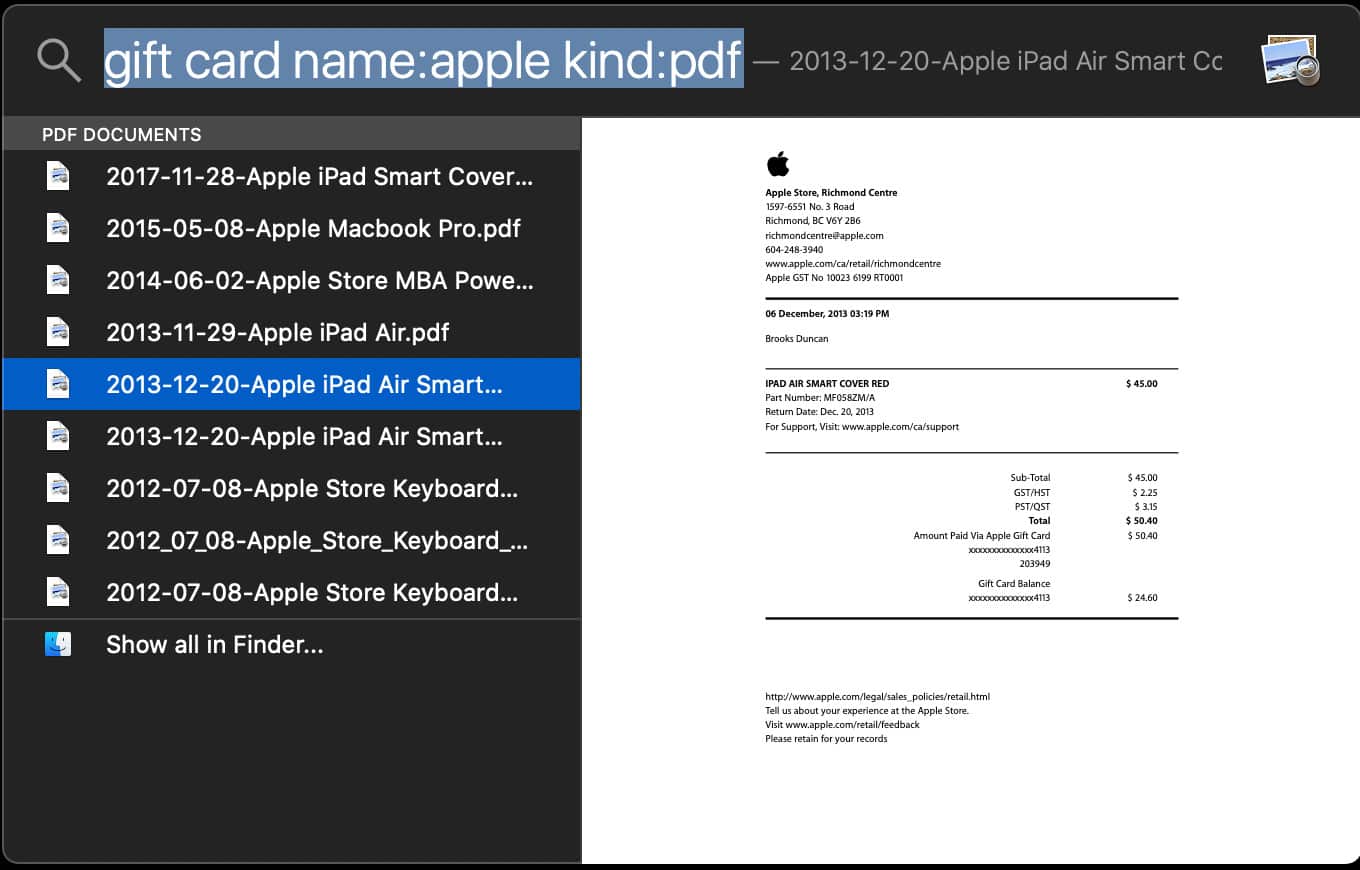
If you needed to locate a specific invoice, meeting agenda, credit card bill, or mind map, how long would it take you? How about if it was in digital form? Would that change things?
A while ago, I was working away, and I received a message from my bookkeeper. Here is what she asked:
Hey Brooks, back in Dec 2013 Apple gave you a $75 account credit on the purchase of your iPad. Do you know if you have used that up yet?
The answer was no; I did not know if I had used it up yet. I was pretty sure I had, but my memory for things like this is, to put it mildly, suboptimal.
Thankfully, a few seconds and keystrokes later, I had a PDF in front of me that showed that I had, in fact, used it up back in 2013.
Organizing your digital information doesn’t have to be complicated — I would say that many people make it too difficult — but it is an area of productivity where a tiny bit of thought up-front will pay off for years and years.
The opposite is also true: having disorganized files, documents, notes, and information will be a constant productivity drag.
The Problem With Digital Disorganization
We talked about this when we wrote about how to organize your folders and documents. When your electronic documents are disorganized, you end up wasting a lot of time trying to find email attachments you saved, meeting notes from that meeting two weeks ago, the headshot for that speaking engagement, and everything else we all reference multiple times a day.
If you pay attention to how many times you access documents, files, or notes throughout the week, you’ll be surprised.
As we talked about on the podcast, digital clutter will become more and more harmful over time.
We’ve helped thousands of people with their productivity, and there is almost always a consistent theme: digital overwhelm and not being able to find things.
Focus On Your Electronic Organization Goals
Can you do too much organization?
There’s an unlimited number of apps, tools, methods, and strategies for organization. It can be really easy to create complex filing systems and Macgyvered-together-with-duct-tape electronic tools.
We recommend that you step back and think about your goal:
Is your goal to create an awesome filing system? No — your goal is to do your work or live your life. You are organizing things so that you can find the information you need when you need it. This is key.
In this article, we’re going to give you some rules for organizing your electronic files, documents, notes, and information. We’re talking:
- “Filing cabinet” documents
- Active project documents
- Reference materials
- Meeting Notes
- Other notes/checklists/ & random information
How To Organize Your Electronic Documents
Before we dive into the rules, a quick primer on electronic documents specifically, or what I call “filing cabinet documents.” In our opinion, the essential things for organizing these types of documents are:
- Having a consistent and descriptive naming convention
- Having a simple filing system that works for you and the documents you are working with
We cover this extensively in our article The Most Effective Way to Organize Your Files, Folders and Documents, so take a detour there and come back for these rules that apply to all types of electronic information.
Rules To Organize Your Information
1. Name The Item, Not Just The Folder
Have you ever seen a filing structure like this? A bunch of folders and subfolders that are named, but the files or notes inside them aren’t?

The thought process makes sense — when you are looking at the folder, you (theoretically) know what the file is. Why bother naming it?
This is a very paper-based organization mentality because when you are accessing a paper file, there is only one way: by digging through a folder and eyeballing each piece of paper.
By giving each document a useful name, you unlock the power of digital. You can see exactly what it is you are looking at without having to open up the file and using search (more on that later), you can zoom right to the piece of information you are looking for. In this example, I would rename it to “202007-aquastars-swim-center-invoice.pdf”.
Giving thought to how you name things is the most important thing you can do to be able to find them later.
2. Use Simple But Intentional Organization
Many people tend to create immense, deep hierarchical folder structures. The problem with this is that it takes too long to save things, and too long to dig around to find what you need.
We recommend that you choose a simple organizational structure and system that means something to you.
We recently recorded a podcast with Tiago Forte, and he recommends that you make sure that actionable items are separate from non-actionable.
We outlined one file organization structure in our document organization, but speaking of Tiago, I am fascinated by his PARA method. I don’t use it personally, but one benefit is that you can use it everywhere you store information: file storage, task management, and note-taking.
PARA stands for:
- Project: a series of tasks linked to a goal with a deadline. For example, “Jane Smith MacBook Setup.”
- Area of Responsibility: An area of your work or life. For example, “Fitness” or “Professional Development.”
- Resources: A topic or theme of ongoing interest. For example, “Gardening” or “Javascript.”
- Archive: Inactive items from the other categories. So when you’re done with a project or an Area of Responsibility or Resource doesn’t apply anymore, you can move it here.
Whatever method you use, try your best to resist fiddling. There is nothing less productive than spending all your time messing around with your note-taking system and not spending enough time on what will make an impact on your life.
For example, I know many people love Notion, and we even have a course about it in The Dojo, our popular online productivity community. One reason I don’t use it because I don’t trust myself not to fiddle endlessly and spend all my time watching Notion Youtube videos.
3. Use The Right Tools For The Job
Speaking of tools, everyone’s dream is to have one tool that does EVERYTHING. One tool that does notes, tasks, long-term file storage, long term goal planning, standard operating procedures, and collaboration.
You should consolidate as much as possible, but it is better to have a few tools that do things well than one tool that does some things poorly.
For example, at AE, we use JIRA & Confluence for all of our project management, but we don’t store project files there even though it is possible. We keep them in Dropbox and use Slack for collaboration.
This works because the tools are integrated and because we can point to resources in another system. It is OK to use multiple systems if you can direct other people (or yourself) directly to the resource.
When everything is integrated, you can have the best tools, and it feels all seamlessly working together as if you had one app.
4. Learn To Search, Ideally With The Keyboard
This depends on the tool you are using, but almost ANY tool will let you search to find what you need.
Using my example from the start of this article, when my bookkeeper asked me the question about the iPad credit, here was my thinking process.
I knew that I wanted to find a document with the following characteristics:
- Documents that are PDFs
- With Apple in the name
- With “gift card” in the text of the document
So I fired up Spotlight on the Mac and typed in the following:
gift card name:apple kind:pdf
Boom. It brought up the PDFs that I needed.

You can do the same thing on Windows by hitting Ctrl-F in File Explorer and typing gift card name:apple kind:document
If you can, try to use the keyboard to search. It makes things much faster.
Examples:
- Win-S to search Windows
- Ctrl-F to search Windows File Explorer
- ⌘-Space for Spotlight on Mac
- ⌘-O to jump to Project/Context in OmniFocus
- ⌘-J, Ctrl-Shift-N Jump in Evernote
If you want additional help learning to get into the search mindset, we have a course in The Dojo called How to Become a Search Ninja and Quickly Find Everything You Need on Your Computer.
Action Steps
Here is where we recommend you go next:
- Look at the tools you use to organize your information. Are you using the right tools for the job? Anything you can consolidate? Or are you suffering with a bad feature and maybe could split out to a better app?
- Try doing some searches in the tool(s) that you use to store information. Learn how search works, and you will become a search ninja in no time.
If your organization is a mess right now and you want quick help on decluttering it, then check out our mini course Digital Declutter.
